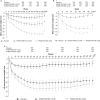Phentermine and topiramate extended-release: a new treatment for obesity and its role in a complications-centric approach to obesity medical management
- PMID: 23738843
- PMCID: PMC3786546
- DOI: 10.1517/14740338.2013.806481
Phentermine and topiramate extended-release: a new treatment for obesity and its role in a complications-centric approach to obesity medical management
Abstract
Introduction: Weight-management options include lifestyle modifications, bariatric surgery and, until recently, limited pharmacotherapy. Phentermine and topiramate extended-release (phentermine/topiramate ER) has recently been approved in the USA for chronic weight management in obese adults and overweight adults with weight-related co-morbidities in conjunction with a reduced-calorie diet and increased physical activity.
Areas covered: This review describes the pharmacology and clinical trials data for phentermine/topiramate ER and its role in a complications-centric approach to medical care of the overweight and obese patient.
Expert opinion: Phentermine/topiramate ER is an effective and safe weight-loss medication that can produce and sustain approximately 10% loss of body weight. This is a landmark development in the pharmacotherapy of obesity. By offering an effective medical option to complement lifestyle and surgical approaches, phentermine/topiramate ER enables a comprehensive medical model for obesity care. The overall approach to the overweight and obese patient should be to identify individuals who will benefit most from therapy based on cardiometabolic or mechanical complications, establish therapeutic targets and goals for ameliorating these complications and selecting the treatment modality and intensity for weight loss to achieve these goals. This complications-centric model emphasizes weight loss as a tool to ameliorate obesity-related complications and optimizes benefit/risk for achieving the best outcomes in overweight/obese patients.
Figures



References
-
- Flegal KM, Carroll MD, Kit BK, Ogden CL. Prevalence of obesity and trends in the distribution of body mass index ... . JAMA. 2012;307(5):491–7. - PubMed
-
- Kolotkin RL, Meter K, Williams GR. Quality of life and obesity . Obesity Rev. 2001;2(4):219–29. - PubMed
-
- National Heart, Lung, and Blood Institute The clinical guidelines on the identification, evaluation, and treatment of overweight and obesity in adults: the evidence report. National Institutes of Health; Bethesda: 1998. NIH Publication No. 98-4083. - PubMed
-
- Klein S, Burke LE, Bray GA, et al. Clinical implications of obesity with specific focus on cardiovascular d... . Circulation. 2004;110(18):2952–67. - PubMed
-
- American Diabetes Association Standards of medical care in diabetes–2013 . Diabetes Care. 2013;36(Suppl 1):S11–66. - PMC - PubMed
Publication types
MeSH terms
Substances
LinkOut - more resources
Full Text Sources
Other Literature Sources
Medical
